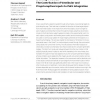Free Online Productivity Tools
i2Speak
i2Symbol
i2OCR
iTex2Img
iWeb2Print
iWeb2Shot
i2Type
iPdf2Split
iPdf2Merge
i2Bopomofo
i2Arabic
i2Style
i2Image
i2PDF
iLatex2Rtf
Sci2ools
PRESENCE
1998
1998
Locomotion Mode Affects the Updating of Objects Encountered During Travel: The Contribution of Vestibular and Proprioceptive Inp
In two experiments, subjects traveled through virtual mazes, encountering target objects along the way. Their task was to indicate the direction to these target objects from a terminal location in the maze (from which the objects could no longer be seen). Subjects controlled their motion through the mazes using three locomotion modes. In the Walk mode, subjects walked normally in the experimental room. For each subject, body position and heading were tracked, and the tracking information was used to continuously update the visual imagery presented to the subjects on a head-mounted display. This process created the impression of immersion in the experimental maze. In the Visual Turn mode subjects moved through the environment using a joystick to control their turning. The only sensory information subjects received about rotation and translation was that provided by the computer-generated imagery. The Real Turn mode was midway between the other two modes, in that subjects physically tur...
Maze | Mode | PRESENCE 1998 | Turn Mode |
| Added | 23 Dec 2010 |
| Updated | 23 Dec 2010 |
| Type | Journal |
| Year | 1998 |
| Where | PRESENCE |
| Authors | Sarah S. Chance, Florence Gaunet, Andrew C. Beall, Jack M. Loomis |
Comments (0)

